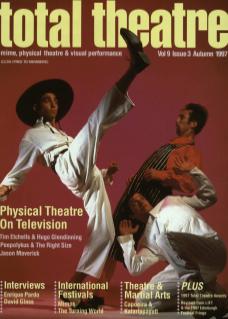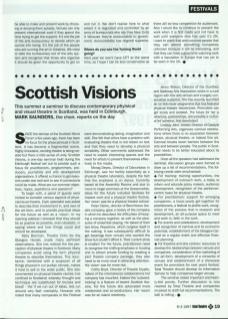Since the demise of the Scottish Mime Forum a few years ago, there has been no focus for the physical/visual in Scotland. It has become a fragmented scene. Highly innovative, exciting theatre is being created but there is little sense of unity. Scottish Visions, a one-day seminar held during the Edinburgh festival set out to provide such a focus for practitioners, programmers, producers, journalists and arts development organisations. It offered a chance to get everyone under one roof and to see if connections could be made. What are our common objectives, hopes, aspirations and passions?
To begin with, a panel of guests were invited to consider various aspects of physical/visual theatre. Each specialist was asked to describe their involvement in, and view of the artform, and to provide practical ideas for the future as well as a vision. In my opening address I stressed that they should be as positive as possible, even idealistic, in saying where and how things could and should be developed.
Mary Brennan, Theatre Critic for the Glasgow Herald, made many pertinent observations. She has noticed the low perception of physical theatre in Scotland. Many companies avoid using the term physical theatre to describe themselves. This reluctance, combined with a suspicion of all things physical in our puritan climate, makes it hard to sell to the wider public. She also commented on physical theatre clichés (not confined to Scotland) whereby 'thought and technique are substituted for bruises and blood' – the ‘if we run out of ideas, lets run around very fast' mentality. However she noted that many companies in the Festival were demonstrating daring, imagination and skill. She felt that critics have a problem with evaluating theatre that is not reliant on text and that they need to develop a physical sensibility. Other comments addressed the need to exploit interesting spaces and the need for artists to present themselves effectively to the media.
Morag Deyes, Director of Dancebase in Edinburgh, saw her facility essentially as a physical theatre laboratory, despite the fact that the emphasis is on dance. Currently based at the Assembly Rooms and due to move to larger premises at the Grassmarket, ideas for the future included facilities for trapeze work and a physical theatre festival. Her ‘vision' was for a physical theatre school.
Peter Clerke, director of Benchtours theatre company, gave a history of the company in which he described the difficulties of keeping a company together, as well as the pleasures of ensemble playing. He talked of their last show, Peepshow, which outgrew itself in the making. It was subsequently difficult to get bookings from venues who wanted the show but couldn't afford it. Their current show is smaller! For the future, practitioners need to recognise the shifting emphasis in funding and to attract private funding by creating a joint theatre company package, they also need to be more vocal in attracting attention. His ‘vision' was for more risk.
Cathy Boyd, Director of Theatre Cryptic, talked of the international collaborations her company has mounted. Indeed this outward-looking is a feature of recent Scottish theatre. For the future she advocated more residencies and co-productions. Her 'vision’ was for an island residency.
Jenny Wilson, Director of the Dumfries and Galloway Arts Association works in a rural region with few arts venues and a largely conservative audience. She has recently launched an 'on the move' programme that has featured physical theatre residencies. Promoters can get lonely and isolated. The future for her is alliances, partnerships, and possibly a 'cultural let' scheme. And devolution!
Lindsay John, Artistic Director of Catalyst Performing Arts, organises carnival celebrations where there is no separation between dance, physical theatre, or indeed fine art. Carnival breaks down barriers between the arts and between people. The public in Scotland needs to be better educated about its possibilities.
Once all the speakers had addressed the seminar, discussion groups were formed to draw up a list of recommendations. The following needs were emphasised:
For training: training opportunities, the development of outreach work, a lobby to inform and educate policymakers, audience development, recognition of the performer-centric basis for physical theatre.
For practitioners: support for emerging companies, a twice-yearly get-together for practitioners, a festival to profile work, recognition of the process that is research and development, an all-purpose space to meet and work in, faith in the work.
For events and celebrations: development and recognition of carnival and its economic potential, establishment of the Glasgow Carnival as a regular event and effective financial planning.
For theatres and arts centres: resources to develop the relationships between venues and companies, consideration of the marketing of the artform, development of a consortia of venues and establishment of a showcase event for promoters for next year's festival. Total Theatre should develop its Information Service to help companies target venues.
The seminar raised important and keenly felt points. Further discussion is now needed by Total Theatre and companies involved to draft full recommendations. The ball is rolling.

